Posted by Filiberto Boncompagni on 01-03-2003 08:56 AM:
Origin and use of design
Dear all,
Given the subject of this discussion, it would be useful to
have the input of some Muslim followers (I think there are a few of them among
our readers). So far there is none, what a pity.
During several years in
the Middle East I do not recall having seen a Muslim pray on a prayer rug
although I saw devotees praying on mats, large carpets, even on cardboard or
newspaper on sidewalks.
Well, true, I could ask around, but the question "Do
you pray on a prayer rug when you are at home?" sounds a little
indelicate…
Even the Mosques I saw had the floor covered with mats or large
machine-made carpets.
However, I never visited Turkey:

This is a scan from Jon
Thompson’s "Carpets From the Tents, Cottages and Workshops of Asia". The picture
is from a Mosque in Central Turkey, 1970’s.
Look at those rugs. They seem to
have the right size but not all of them have the arch/mihrab design.
So,
not all the Prayer Rugs present what we generally consider as a "definer" of the
Prayer Rug design: the arch.
What about those who DO have an
arch?
Let’s look at good old Gantzhorn’s book.
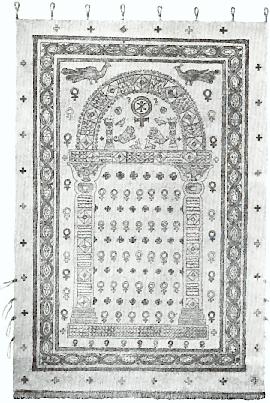
This is a reconstruction of a
Coptic textile of the 6th century probably used to close a tabernacle in a
church altar.
This is another interesting illustration:
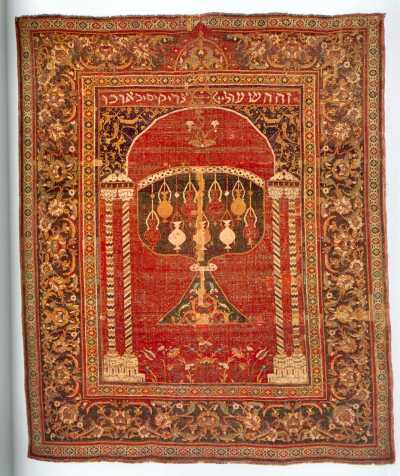
a 16th century "Synagogue
Rug" from TMW (size 186 x 155 cm)..
And this is Armenian:
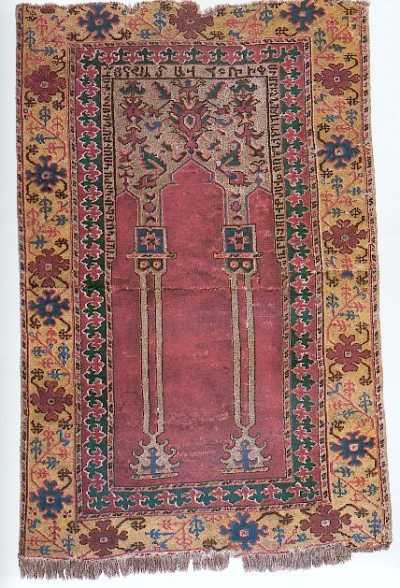
the "Gorzi" rug, dated
1651. According to the inscription it was intended for closing the tabernacle or
a niche in an Armenian Church.
So, we have arch rugs and textiles used
for religious purposes in different faiths.
Let’s look now at another,
very interesting, book: "Arabic Art After Monuments of Cairo" by the Frenchman
Prisse d’ Avennes. He was an architect and engineer who spent several years in
Egypt in the first half of the 19th century.
He studied Islamic culture and
executed drawings concerning architecture and local customs, more or less in the
same period of the more famous British painter David Roberts.
This is the
interior of Ibn Tulun Mosque:
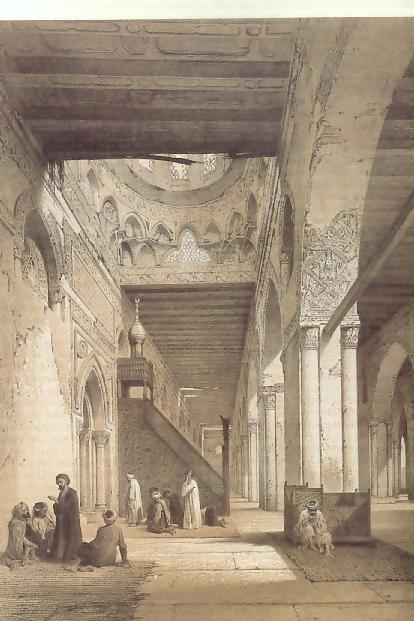
and the Ibn Quala’un one:
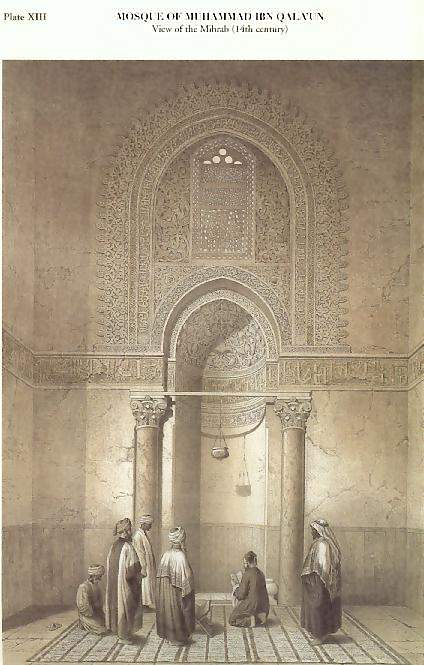
As you can see no rugs, only big
mats, probably straw mats.
Here are two windows in stained glass from
different Mosques:
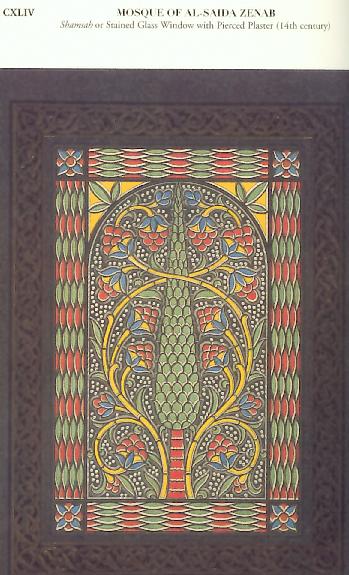
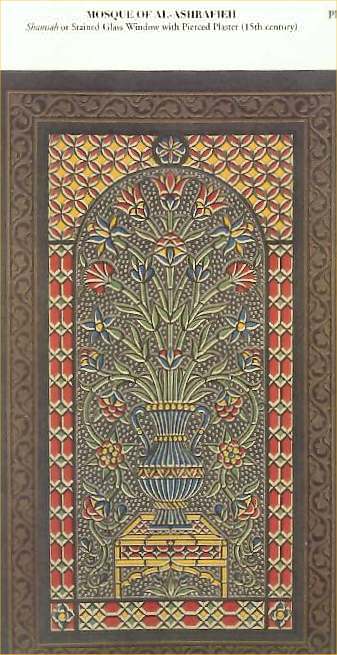
Windows on
Paradise?
But then, if we look at the interiors of a private
house:
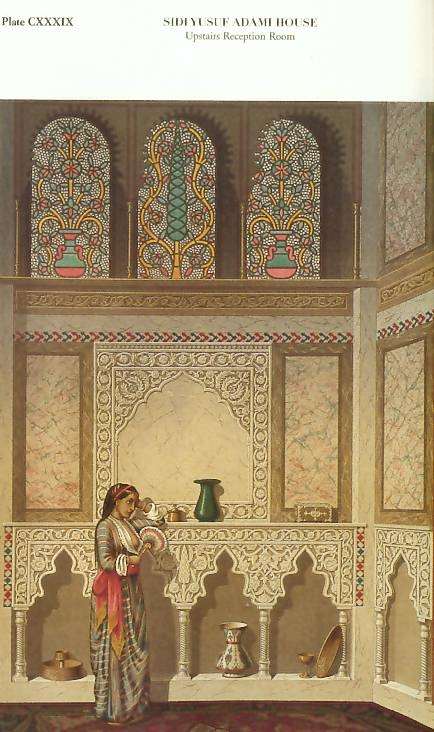
we see
almost the same windows. And niches. And a 2 dimensional Mihrab.
(Notice also
the nice lady’s décolleté - not a common sight in nowadays Cairo  ).
).
So, the same architectural
elements had both a sacred and profane use.
I guess it was the same for
"Mihrab" rugs.
Regards,
Filiberto
Posted by Ali R.Tuna on 01-03-2003 03:44 PM:
Dear Filiberto,
First an "a parte" - you should absolutely visit Turkey.
This is missing in your rug culture and for your life enjoyment !
The
prayer rug is a very personal item and the floor covering of mosques in general
should not be mixed with the individual prayer rug.
This is why you can find
all sorts of coverings in mosques , as long as it can be kept clean.
Especially, in a mosque the direction of the mosque's mihrab is clear so
no need for special indication. The only help you might require in a mosque is
the alignment of the prayer in "safs" (literaly rows) . So a pattern helping
alignment of the fidels in a relatively compact manner is mostly used for mosque
floor coverings.
This is not to say that the mosques will not have saf
rugs with niches. The best knowns are the ones that were taken out of the
SElimiye Mosque in Edirne after the occupation of the city during the Balkan war
by non Turkish troops. Fragments of these are now in several private
collections.
The current modern wall to wall coverings of the SElimiye mosque
(Edirne) , the Sokollu Mehmet pacha (Istanbul) , Suleymaniye (istanbul) are all
with safs with mihrabs.
I am posting a rare picture of the Alaeddin Mosque in
Konya taken in 1913 (from Illustration magazine, by chance in colour) which
shows the floor covering. You can see the diversity.
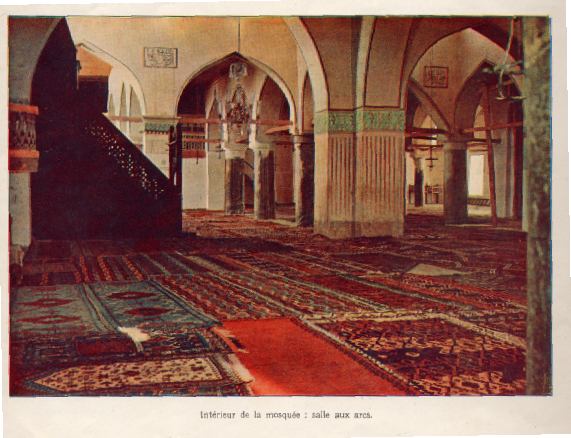
However, the detail from bigger
scan shows two individual prayer rugs with mihrabs.
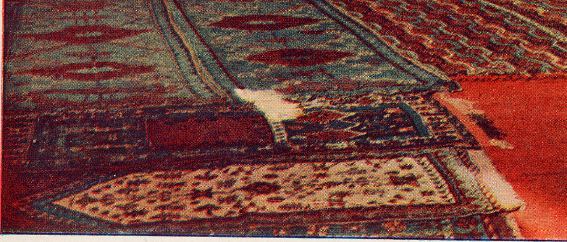
Individual prayer rugs in mosques
will be found in the niche of imam and some for the muezzins(the callers to
prayer) . The ones for the imams are particularly interesting. To match the
rectangular format to the rounded form of the niche they are usually folded on
the top corners . Some are even cut at the edges, or they got worn out and take
a rounded form .
Most of the individual prayer rugs were made for muslims
to pray at home . They were usually laid at one corner and most of the time
stayed or just rolled to avoid the fold/unfold effort five times a day. A lot of
them were not knotted carpets ( usually embroidered felt , silk or cotton in
rather wealthy families). This was expensive and probably also not very
practical. I tend to think that the knotted forms with mihrab were more for
status for religious notabilities or more wealthy families.
This is also
consistent with the families of prayer rugs we can observe : (i)the Topkapi silk
prayer rugs family with niches and versets from the Coran , now dated to 16th
century and attributed Persia , (ii) the corpus of prayer rugs from Mucur-
Kirsehir found in the Konya Mevlana Sufi Shrine all have niches and clear
mihrabs.
I post here another prayer rug picture from Mucur that for me
carries a lot of the prayer symbolism and the religious journey. It is woven in
reverse direction to the picture.
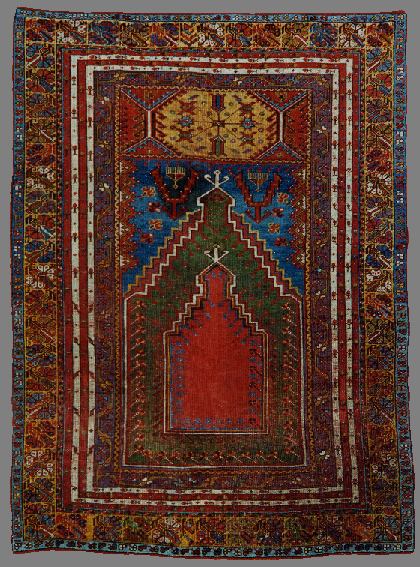
Whichever way the designs were originated they have gained a
religious symbol from 16th century on. This said, there are a lot of prayer rugs
without niches or gables around, but they are not identified as such. Especially
the Bergama area produced a lot of them .
Ali R. Tuna
Posted by Steve Price on 01-03-2003 04:59 PM:
Hi Filiberto,
First, I completely endorse Ali's recommendation of
Turkey as a tourist destination. It is endlessly interesting, with people who
pamper visitors shamelessly.
The series of pictures you added really show
the relationship of colonnades to columns on some prayer rugs very nicely, and
there can be little doubt that this is the origin of that design element in the
rugs. On the other hand, in later pieces - say, after the mid-19th century - the
columns often look less architectural. I think this is another example of the
degeneration of weaving art that occurred with the pressures of massive
commercialization to the west that occurred after about 1850, with the weavers
not understanding the traditional significance of what they were depicting.
Hence, things like the Ballard rug (shown in another thread), with columns that
look all wrong architecturally (they have points at one end, rather than the
usual wide bases, for instance) and other motifs that are upside down relative
to the direction the rug would take if the columns were supports for an arched
ceiling.
I've done the "mosque tour" in every city I visited in Turkey,
and, as Ali notes, these are not the places to look for individual prayer rugs
on the floors. Most are covered with large machine made carpets or inexpensive,
mass produced carpets from India or Pakistan.
Finally, we have had a
number of Moslem graduate students in our institution (including several from
Ammann, where Filiberto is), and most of them use small, machine made mercerized
cotton rugs as clean places to pray within the laboratories and offices.
Regards,
Steve Price
Posted by Filiberto Boncompagni on 01-04-2003 03:20 AM:
Thank you Ali for your much needed contribution!
I have to add a note
to my first posting on this thread.
When I wrote it I wad keeping an eye on
Jeff Spurr’s introduction to NERS Online Exhibit "Prayer Rugs & Related
Textiles"
http://www.ne-rugsociety.org/
and I forgot to clearly point
out the similarity of iconography between the stained glass windows and rugs
with niches and trees and/or vase design, thinking it was evident enough.
As you can see the Mosques to which the first two windows belong are
respectively of the 14th and 15th century.
I do not know if the windows are
that old (the stained glass could have been added later) but this demonstrates
that such motives were around for some time in architectural
form.
I’ll try to follow your (and Steve’s) advise to visit
Turkey.
Best regards,
Filiberto









 ).
).

